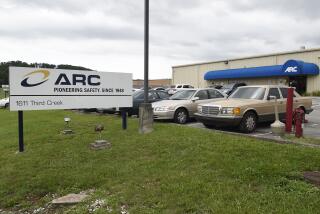Aerobag Vest Falls Flat as Protective Wear
- Share via
The wearable air bag for motorcyclists: It’s an idea whose time has not yet come.
Maybe someday all safety-conscious riders will wear inflatable suits that will, in the event of accidents, suddenly fill with air and shield us from harm, making us look like Pillsbury Doughboys in leather.
But judging from our test of Aerobag, a Japanese-made air-bag vest that will be available in the United States early next year, that day is still a long way off.
The idea is intriguing. The polyester vest, which comes in a variety of bright colors, has an air-bag system inside its lining. A pull cord that comes out of a small hole in the front is attached to a carbon-dioxide-filled cartridge that resides in a vest pocket.
The user attaches the end of the cord to the motorcycle frame. In case of a mishap that causes the rider to fall off the bike, the cord pulls away to activate the cartridge and inflate the vest.
Mechanically, the Aerobag, which will sell in this country for $420, seemed to work well. Of course, we didn’t try an actual crash test.
“I’m not aware of anyone who does crash tests on motorcycles, even with a crash-test dummy,” said Julie Rochman, a spokeswoman for the Insurance Institute for Highway Safety. “I don’t think anyone could expect the rider would do very well. Unlike cars, motorcycles aren’t built for crash protection, so why test for it?”
JAS America, the Los Angeles firm that is importing the vest, did send along a video showing a test rider performing a slow-speed crash into the side of a parked Jaguar (“Oh, no, don’t hurt the Jaguar!” one of my nonmotorcyclist colleagues exclaimed as we watched the test). The rider was shown flying up in the air a bit, coming down on the hood of the car and sliding off unhurt.
*
But our informal noncrash test in a Times parking lot revealed several shortcomings. Because the garment is a vest, it leaves the arms exposed to injury. Indeed, on the product’s Web site, at https://www.aerobag.com, models are shown wearing T-shirts with their arms bare, meaning they could be terribly injured even in a slow-speed accident.
JAS officials say they will eventually import a jacket-style Aerobag, but it was not yet available for testing.
In our test, the vest version inflated readily with a yank on the cord by a colleague, but most of the air-bag protection is in the back--the very area the video test rider landed on. Landing on the chest or belly would be far more problematic.
The largest vests to be imported by JAS America, at least at the beginning, are Japanese-size extra large, which are not large at all by U.S. standards. I’m just a shade under 6 feet tall, and the largest available Aerobag vest came up short on me. When zipped all the way up, it hugged my neck snugly, so much so that when inflated, the vest closed tightly on my windpipe. I suddenly couldn’t breathe or talk.
And with riding gloves on and the blown-up vest giving me all the mobility of the Michelin Man, I couldn’t get the darned thing unzipped. The photographer luckily jumped forward and yanked the zipper down, but not before several so-called friends watching the test got a good laugh out of the episode.
More seriously, the vest material is not the heavyweight leather or Cordura nylon widely recommended for protective wear. I question whether the polyester would withstand a high-speed crash without ripping apart, exposing the body.
*
Which brings up another point. Although the National Highway Traffic Safety Administration extensively tests safety equipment for automobile drivers, the only analogous equipment it tests for motorcyclists is helmets. No government agency tests protective motorcycle jackets or pants to determine which ones might offer superior protection.
“It’s the kind of thing we might do in the future,” said Ray Tyson, public affairs director for NHTSA and himself an avid motorcyclist. The agency is in the midst of a project called the National Agenda for Motorcycle Safety that will, among other things, reexamine motorcycle equipment standards and determine what types of gear the government should regulate or test.
NHTSA used to do more extensive testing of motorcycle equipment. In fact, some officials recall that about 20 years ago, the agency tested an inflatable suit made in England.
The testers found that “it was clearly impractical,” said NHTSA spokesman Tim Hurd. “Very bulky, and the fabric was not abrasion-resistant. It was also some odd pink or fuchsia color.”
Two decades later, the quest for the perfect motorcyclist air bag goes on.
*
Two-Wheel Ride surveys the Southern California motorcycle scene. David Colker can be reached at david.colker@latimes.com.
Cycle Shop
* If you missed our Sept. 23 themed issue on motorcycles, check out the archives on our Web page: https://www.latimes.com/highway1.







